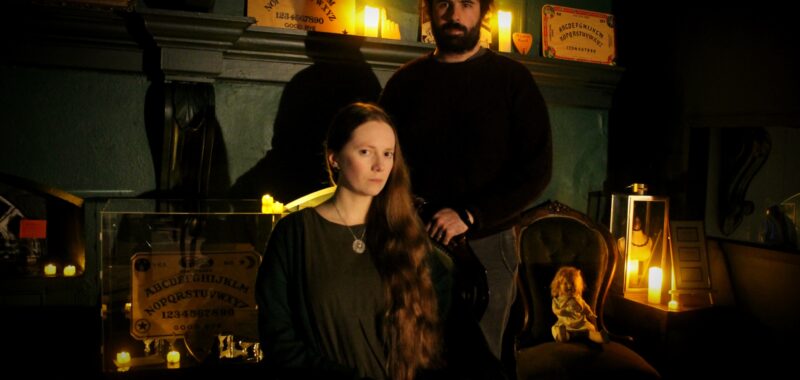Interested in learning about “Victorian mourning hair” or seeing an (ostensibly) haunted Ouija board and cursed painting? This Halloween, the Rowtons’ Museum of the Paranormal and Spirituality will hold its grand opening. Housed in the Penuel Chapel in Carmarthen, Wales, the museum will exhibit objects telling the stories of the spiritual and supernatural and present historical reenactments of Victorian-era séances.
While there are a number of paranormal museums around the world, many of them tend to fetishize spiritualist, witchcraft, and pagan objects. The Rowtons’ Museum, meanwhile, is part of a wider movement in cultural institutions to dive deeper into the histories of the communities represented in their collections.
Founders Laura and Erik Rowton created and currently host the Paranormal Scholar YouTube channel, where they seek an “objective exploration of the strange and spooky.” They adopt this approach in their new museum, which aims to strike a balance between the popular and academic while presenting authentic religious diversity.
In terms of objects, Laura Rowton explained to Hyperallergic, there are those which have a historical and documented relevance to the collection, and then “there are ones which we have either come across personally or have been given to us and have a paranormal significance, or are alleged to have a paranormal significance.” Objects shown in the 19th-century Baptist chapel focus on the former — telling the stories of non-conformist communities of faith — while the adjoining schoolroom hosts the latter.

The museum will be one of the first of its kind in Wales, a country with its own rich history of spiritualism. In the mid-1700s, Carmarthen saw the persecution of religious nonconformists — such as the Baptists who built this chapel. “At the end of the 19th century, when spiritualism was at its peak, the building is said to have witnessed its own spiritual history in terms of faith healing,” Laura Rowton said.
Connecting with this history is essential because for the Rowtons, the chapel is the largest object on the grounds and one that, like their séances, visitors can walk through and experience firsthand.
“It’s one thing to tell people what happened during a Victorian séance and have it written down and in a glass case,” Laura Rowton said. “But that’s completely different from saying, ‘How about you sit down at a table and let’s see what it would have been like?’”
A similar approach can be seen at the Peabody Essex Museum in Salem, Massachusetts, which regularly hosts local magicians as part of its ongoing exhibition Conjuring the Spirit World: Art, Magic, and Mediums.

In fact, inviting spiritual practitioners to engage meaningfully with objects mirrors a wider call for museums to study, understand, and respond to the sacred dimensions and cultural needs of spiritually charged pieces in their collections.
Curators Lara Goodband and Gemma Lloyd invited contributors to their exhibition Earth Spells: Witches of the Anthropocene at the Royal Albert Memorial Museum and Art Gallery to respond to a recent donation of a cauldron previously used by Elizabeth Webb, or the White Witch of Dartmoor. The Ryedale Folk Museum in North York Moors has a witchcraft exhibition featuring crystal balls and “witch posts” that will be up until November 17.
Similarly, in January, the Pitt Rivers Museum hosted “Amulets, Charms, and Witch Bottles,” a workshop in which practitioners discussed how the museum’s collection and curation of magical material cultures affect contemporary Pagan communities.
The American LGBTQ+ Museum and the New York Historical also invited LGBTQ+ witchcraft practitioners to a panel focused on modern queer reclamations of religious diversity in museums.
“Some histories have been actively erased, have been devalued essentially, and the interest is shedding light on that evolution and restoring value by uplifting the voices of those that have been so hidden and erased in the past,” S.C. Lucier, senior associate of Public Programs and Partnerships at the American LGBTQ+ Museum, told Hyperallergic.

Like these four institutions, the Rowtons hope their museum will explore the difficult realities of marginalization and violence, especially given the town’s own history.
“We hope that by putting them on display, people who ordinarily feel marginalized in their beliefs will feel like they’re represented and they can come and engage with them,” Laura Rowton said.
This engagement is critical, the Rowtons explained, because many objects in their collections, such as a “Nkisi Nkondi Power Figure” spirit vessel, fall outside of their scope as Victorian spiritualists. “There are certain things we don’t claim to be and we would never try to muscle on someone else’s space,” Laura Rowton said. “Instead we try to present them in as faithful a way we are able to and then invite feedback from people from those communities to improve those exhibits.”
As with other present museums of the paranormal, the Rowtons’ Museum is connected to a long history of exploitative displays, including colonial-era “curio cabinets” featuring unethically acquired objects. These cabinets exoticized religious traditions outside of Christianity — not unlike art institutions today.
Largely as a result of this, the Rowtons’ experiential approach, engagement with spiritual communities, and exhibitions unpacking histories of violent persecution represent a wider movement to deconstruct religious colonialism and engage meaningfully with spiritual diversity in museum collections.

